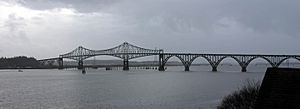Conde McCullough Memorial Bridge facts for kids
Quick facts for kids Coos Bay Bridge |
|
|---|---|
 |
|
| Coordinates | 43°25′51″N 124°13′20″W / 43.43072°N 124.222336°W |
| Carries | |
| Crosses | Coos Bay |
| Locale | North Bend, Oregon |
| Official name | Conde B. McCullough Memorial Bridge |
| Maintained by | Oregon DOT |
| Characteristics | |
| Design | Cantilever through-truss |
| Total length | 5,305 ft (1,617.0 m) |
| Longest span | 793 ft (241.7 m) |
| Clearance below | 150 ft (45.7 m) |
| History | |
| Opened | 1936 |
|
Coos Bay Bridge No. 01823
|
|
| Built | 1934–36 |
|---|---|
| MPS | McCullough, C.B., Major Oregon Coast Highway Bridges, 1927-1936 |
| NRHP reference No. | 05000817 |
| Added to NRHP | August 5, 2005 |
The Conde B. McCullough Memorial Bridge is a really cool cantilever bridge. It stretches across Coos Bay in Oregon, carrying U.S. Route 101. You can find it near North Bend, Oregon.
When it was finished in 1936, it was first called the Coos Bay Bridge. Later, in 1947, it was renamed to honor Conde B. McCullough. He was a very important engineer who designed this bridge and ten other big bridges along the Oregon Coast Highway.
This amazing bridge replaced the ferries that used to cross the bay. It's known for its beautiful design and careful details. Because of its importance, it's now listed on the National Register of Historic Places. This means it's recognized for its special design and its role in the area's history and economy.
History of the Bridge
Building what was then called the Coos Bay Bridge started on July 10, 1934. Glenn S. Paxson was the main engineer during construction. He took over while McCullough was working on other projects. Raymond Archibald was the resident engineer at first. Later, Dexter R. Smith took over in 1935.
The company Northwest Roads Company built the piers and concrete parts. Piers are the strong supports that hold up the bridge. The steel parts of the bridge were built by the Virginia Bridge and Iron Company. The main piers stand on piles driven deep into the bay's bottom.
The huge main towers of the cantilever section were made somewhere else. They were brought to the bridge site in four big pieces. Workers built the cantilever arms outwards from the towers. The part reaching towards the shore was built a little faster. This helped keep the bridge stable during construction. The concrete arch sections were built using temporary wooden supports. The bridge officially opened in June 1936.
When it was finished in 1936, this bridge was the longest in Oregon. It was also the most expensive of the Oregon Coast bridges. It cost about $2.14 million back then. That's like $35 million today! Because these five big coastal bridges were so costly, the government's Public Works Administration helped pay for them. In 1947, the bridge was dedicated to its designer, Conde McCullough.
On December 4, 1986, a Swedish ship called the Elgaren accidentally hit the bridge. The ship was entering the harbor during a very high tide. A ramp on the ship couldn't be lowered in time, causing the accident. The bridge had to be closed for repairs.
What the Bridge Looks Like
Engineers chose a cantilever bridge design for this spot. This was because the bay needed long spans and had a busy shipping channel. A drawbridge (one that opens) was not a good idea. It would have to open too often for ships.
The main span of the bridge is 793 feet (242 m) long. It gives ships 145 feet (44 m) of space to pass underneath. The entire steel cantilever section is 1,708 feet (521 m) long. Including the concrete parts leading up to it, the bridge is 5,305 feet (1,617 m) long in total. The approach sections are made of concrete arches. These arches are a common feature in McCullough's bridge designs.
The main roadway is 27 feet (8.2 m) wide. There are also sidewalks on both sides, each 3.5 feet (1.1 m) wide. The main towers rise 280 feet (85 m) above the water. They have curved supports that look like Gothic arches. The concrete approach arches vary in size, from 265 feet (81 m) to 151 feet (46 m) long.
At each end of the bridge, there are special areas for people. These "pedestrian plazas" are perfect for viewing the bridge and getting to the shoreline. They have cool Art Moderne designs and built-in benches. Stairs curve down from these plazas to the park below.
Important Recognition
The city of North Bend, Oregon often uses pictures of the bridge. You can see it in their public relations materials. The bridge was added to the National Register of Historic Places on August 5, 2005. This shows how important it is to history and engineering.
Images for kids



